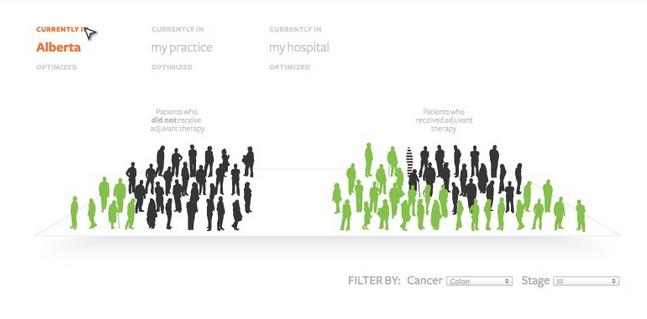
Interactive infographic: UAlberta grad student Jennifer Windsor worked with Alberta doctors to design a visualization tool that renders complex provincial data on colorectal cancer in an easy-to-understand form.
(Edmonton) Colorectal cancer is the second leading cause of cancer deaths in Alberta-a reality that may soon change because a University of Alberta arts student, with doctors in the province, has designed a tool that will deliver on one of the targets the Alberta government has set its sights on as it tries to turn that statistic around.
Jennifer Windsor, a graduate student in the U of A's Humanities Computing program, submitted the tool,Colorectal Cancer Outcomes in Alberta Visualization, to an exhibition that opens today at the FAB Gallery.
Windsor's creation is among more than 30 works showcased in InSight 2: Engaging the Health Humanities, which runs until June 8. The tool will be used to help diagnose and treat colorectal cancer.
Another piece by Andrea Van Der Ree, a recent design graduate student, aims to help children with autism spectrum disorder. She worked with families and health-care professionals to develop a customized board game that helps kids with autism learn social skills such as recognizing people and expressing emotions.
Aidan Rowe, professor of design studies at the U of A, says the exhibition explores ways of bridging the historic gap between medicine and the arts."Normally we think of the disciplines of medicine and dentistry and arts as separate; we were interested in exploring the connections between the disciplines and finding examples of people working across this stage," Rowe says. "Medical health is not something that can be attained only in a clinical way. If we think of health in a more holistic way, there are varieties of treatment opportunities that are possible. The U of A has a history in this area. The idea is that medicine can be conceived of beyond a scientific, black-and-white diagnostic process."
Taken together, the three dozen works that make up the multimedia exhibition offer examples of some of those possibilities, Rowe says.
"Oftentimes these people don't have opportunities to talk to each other. But we've forced different types of work together. You might see a series of poems by someone who has been through the health-care system, a large video about how the oilsands affect our health and, right next to that, a quilt by students exploring their experiences of being a medical student. Those juxtapositions bring people together," he says. "An interesting submission comes from the government of Alberta, about work they've been doing on educating Albertans about issues relating to aging and youth."
Transforming health care by design
A companion two-day symposium, Design, the Health Humanities and the Community, is being held at the Edmonton Clinic Health Academy and the Katz Centre. Rowe and co-curators Pamela Brett-MacLean, director of the Arts & Humanities in Health & Medicine program, and Bonnie Sadler Takach, professor of design studies, say the symposium is an opportunity to imagine and design innovative and transformative processes, communications and products that can help promote collective health and well-being.
The trio will publish a white paper next year. But before that, students in a spring-session design class will head into the community together with others from dentistry, medicine and health humanities medicine, to identify and work on issues.
"We want to push students outside the classroom space, getting them to work with communities," says Rowe. "In our design studies program, much of our work looks at social design; we're interested in design that deals with the betterment of humanity. That's at the core of our philosophy, so this class is a natural flow from that."